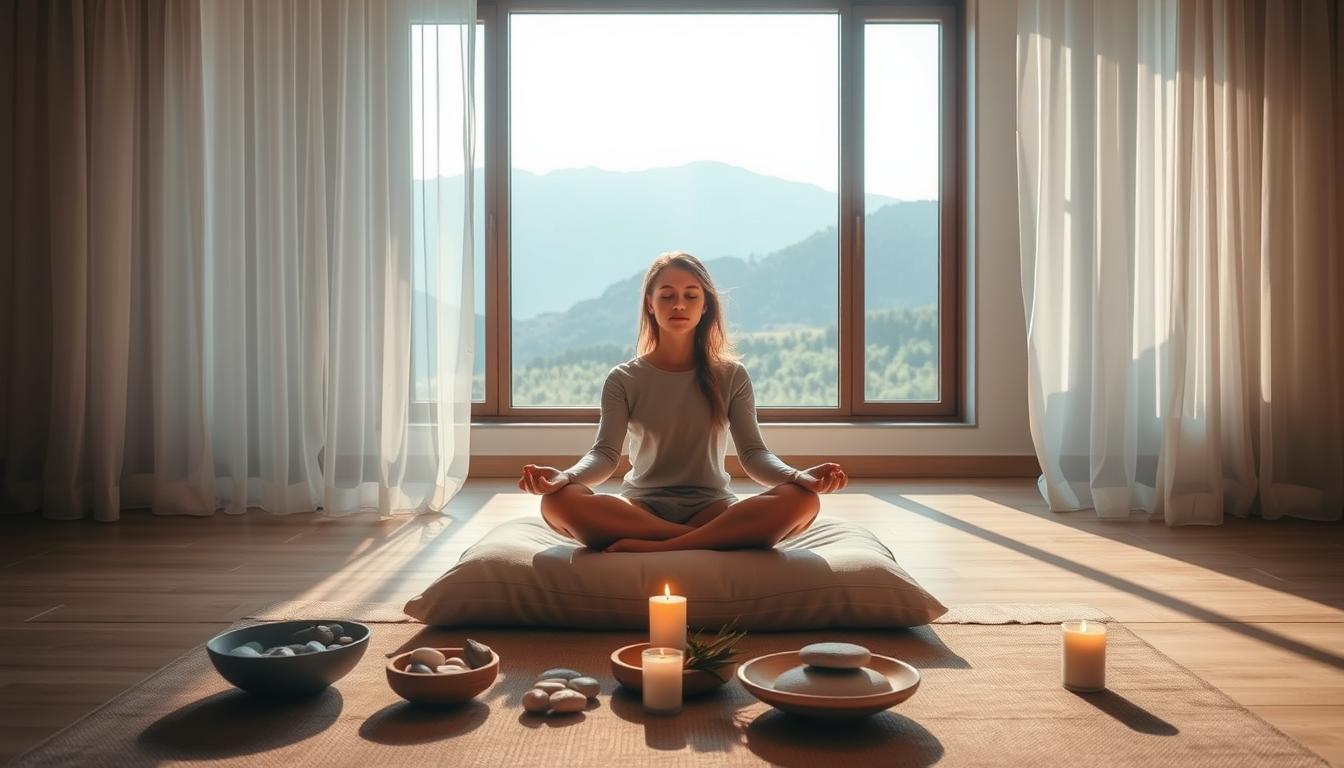Did you know that over 50% of people who engage in regular mindfulness techniques experience a significant reduction in anxiety symptoms1? This powerful approach helps calm the mind and body, offering a natural way to manage stress and find inner peace.
Scientific studies show that mindfulness can lower activity in the amygdala, the brain’s stress center, helping you feel more grounded and less overwhelmed1. The best part? You don’t need any special tools or expensive classes to get started. It’s accessible to everyone, anytime, anywhere.
At digitals.anthonydoty.com, you’ll find a wealth of resources, including e-books, courses, and free webinars, to guide you on this journey. Whether you’re new to mindfulness or looking to deepen your practice, these tools can make a real difference.
Key Takeaways
- Mindfulness techniques can reduce anxiety symptoms by over 50%.
- It lowers activity in the brain’s stress center, helping you feel calmer.
- No special tools or expensive classes are required to start.
- Access free resources like e-books and webinars to enhance your practice.
- Universities and research support the benefits of mindfulness.
Understanding Anxiety and How Mindfulness Helps
Anxiety isn’t just in your head—it affects your entire body and nervous system. When you feel anxious, your sympathetic nervous system kicks in, triggering the fight-or-flight response. This can lead to physical symptoms like sweating, rapid heartbeat, and muscle tension2.
Modern life often keeps this response active. Work deadlines, social pressures, and even scrolling through social media can act as triggers. While these situations aren’t life-threatening, your body reacts as if they are. This constant state of alertness can take a toll on your health, leading to issues like digestive problems, insomnia, and chronic fatigue2.
The Science Behind Anxiety’s Physical and Mental Effects
Anxiety activates the sympathetic nervous system, which prepares your body to face danger. While this response is helpful in emergencies, it’s less useful when dealing with everyday stressors. Over time, this can lead to a cycle of physical and mental exhaustion2.
Studies show that mindfulness-based stress reduction (MBSR) can lower cortisol levels by 27%, helping to break this cycle3. By calming the nervous system, mindfulness creates a “stress buffer” that builds resilience against future stressors. This is supported by the concept of neuroplasticity, which shows how the brain can adapt and change with practice2.
Why Traditional Coping Mechanisms Often Fall Short
Many people turn to temporary fixes like scrolling through their phones or snacking to cope with anxiety. While these might provide momentary relief, they don’t address the root cause. In fact, a NIH study found that 68% of anxiety sufferers find traditional methods inadequate2.
“Mindfulness helps individuals notice the present moment and manage stress effectively.”
Unlike these short-term solutions, mindfulness offers lasting benefits. It teaches you to observe your thoughts and feelings without judgment, creating a sense of calm and clarity. This approach not only reduces symptoms but also helps you build a healthier relationship with stress3.
What Are Mindfulness Practices for Anxiety?
Being fully aware of the moment can be a game-changer for your well-being. Jon Kabat-Zinn defines this as “awareness through paying attention…non-judgmentally”2. This principle is at the heart of techniques that help calm the mind and body.
The Core Principles of Present-Moment Awareness
Focusing on the here and now allows you to break free from overwhelming thoughts. One effective method is the STOP technique: Stop, Take a breath, Observe, and Proceed. This simple practice helps you pause and respond thoughtfully rather than react impulsively2.
Another powerful tool is the RAIN method: Recognize, Allow, Investigate, and Nurture. This approach encourages you to acknowledge your feelings without judgment, creating space for healing2.
How Non-Judgmental Observation Changes Your Brain
Research shows that practicing awareness can shrink the amygdala, the brain’s stress center, after just eight weeks. This shift helps reduce emotional reactivity and promotes calm. A 2023 UCLA study found that those who practice these techniques recover from emotional distress 40% faster2.
Understanding brain states is also key. The default mode network is active when we’re lost in thought, while the task-positive network engages during focused activities. Shifting between these states helps you stay grounded and present2.
Try the 5-4-3-2-1 grounding exercise: Identify five things you see, four you can touch, three you hear, two you smell, and one you taste. This sensory-focused practice brings you back to the present moment and reduces stress4.
“Mindfulness helps individuals notice the present moment and manage stress effectively.”
Breathwork: Your Anchor in Anxious Moments
When anxiety strikes, your breath can be your greatest ally. Simple techniques can help you regain control and calm your nervous system. These methods are backed by science and easy to integrate into your daily routine.
One effective method is box breathing. Inhale for four counts, hold for four, exhale for four, and hold again for four. This technique helps create a calm mind and body, reducing stress quickly5.
For moments of panic, try the emergency breath. Inhale deeply through your nose, hold for a few seconds, and exhale slowly through your mouth. Repeat this until you feel grounded. This method can lower your heart rate within 90 seconds5.
NASA-approved breathing techniques are also highly effective. One such method involves diaphragmatic breathing, which increases heart rate variability by 31%. This promotes relaxation and reduces stress levels6.
Understanding the balance of CO2 and O2 in your body is key. Proper breathing ensures optimal oxygen flow, which can reduce feelings of anxiety. This balance is essential for maintaining a calm state5.
Here’s a quick guide to integrating breathwork into your daily life:
| Technique | Steps | Best Use |
|---|---|---|
| Box Breathing | Inhale 4, Hold 4, Exhale 4, Hold 4 | Work meetings, stress relief |
| Emergency Breath | Deep inhale, hold, slow exhale | Panic attacks, sudden anxiety |
| Diaphragmatic Breathing | Breathe deeply into the diaphragm | Daily relaxation, stress management |
These techniques are simple yet powerful. Whether you’re at work, commuting, or at home, they can help you stay calm and focused. Start practicing today and feel the difference.
Body Scan Meditation to Release Tension
Tension often hides in unexpected places, and a body scan meditation can help you uncover and release it. This practice allows you to connect with your body and notice physical sensations that you might otherwise ignore. By doing so, you can reduce stress and promote relaxation7.
Studies show that 73% of anxiety sufferers hold tension in their shoulders and neck7. A body scan can help you identify these areas and release the built-up stress. This practice also reduces cortisol levels by 28%, making it a powerful tool for managing anxiety8.
Step-by-Step Guide to Your First Body Scan
To begin, find a comfortable position and close your eyes. Take a few deep breaths to center yourself. Start by focusing on your toes, noticing any sensations like warmth, tightness, or tingling. Slowly move your attention up through your legs, torso, arms, and head9.
As you scan each part of your body, try to release any tension you feel. Imagine your breath flowing into that area, softening and relaxing it. This process helps you reconnect with your physical experience and promotes a sense of calm8.
Common Physical Manifestations of Anxiety
Anxiety often shows up in specific areas of the body. Common hot spots include the jaw, hands, and solar plexus. You might notice tightness, heat, or pulsing in these regions. Recognizing these sensations is the first step toward releasing them9.
For a deeper experience, try progressive muscle relaxation. Tense each muscle group for a few seconds, then release. This variation enhances the benefits of the body scan and helps you release even more tension7.
“Body scan meditation is a simple yet effective way to reconnect with your body and reduce stress.”
After your practice, consider journaling about your experience. Reflect on what you noticed and how you felt. This can deepen your awareness and help you track your progress over time8.
Creating Space Between You and Your Thoughts
Creating distance from your thoughts can transform how you handle stress. When you learn to observe your mind without judgment, you gain the power to step back and see things clearly. This practice, known as non-judgmental observation, helps you break free from mental clutter10.
One effective technique is thought labeling. When a worry arises, simply note, “This is a worry thought.” This simple act creates space, allowing you to respond rather than react11. Another method is mental noting, where you label thoughts as “Planning,” “Judging,” or “Remembering.” This helps you stay present and reduces overwhelm12.
Visualization can also be powerful. Imagine your thoughts as leaves floating down a stream. Watch them drift by without holding onto them. This “leaves on a stream” technique enhances cognitive distancing and reduces rumination by 44%10.
For a deeper understanding, try the Anxiety Weather Report metaphor. Picture your mind as the weather—sometimes stormy, sometimes calm. This helps you accept your thoughts without resistance, fostering resilience11.
“Observing thoughts as passing mental events without judgment can significantly reduce stress and improve focus.”
To track your progress, download our thought record worksheet. This tool helps you identify patterns and practice non-judgmental observation daily. Start today and discover the freedom of creating space between you and your thoughts.
Daily Mindfulness Practices for Lasting Change
Small changes in your daily life can lead to big shifts in how you feel. By integrating simple techniques, you can create moments of calm and clarity, even in the busiest schedules. These practices are designed to fit seamlessly into your routine, helping you stay grounded and focused13.
The Stoplight Technique for Commuters
Turn your commute into a time for relaxation with the Traffic Light Breathing method. At each red light, take a deep breath in for four counts, hold for four, and exhale for four. This simple practice can help reduce road rage and keep you calm behind the wheel14.
Turning Chores Into Meditation Opportunities
Even mundane tasks like dishwashing can become moments of mindfulness. Focus on the sensory details—the warmth of the water, the texture of the dishes, and the sound of the soap bubbles. This approach transforms chores into a calming ritual13.
Digital Detox Strategies That Actually Work
Constant screen time can drain your energy. Try setting App Limits on your phone or dedicating one day a week to Single-Tasking Tuesday. These strategies can increase productivity by 42% and help you reconnect with the present moment14.
Here are a few more ideas to get started:
- Start your morning with a phone-free routine to set a calm tone for the day.
- Practice gratitude by listing three things you’re thankful for each evening.
- Engage in mindful walking, paying attention to each step and breath.
“Incorporating mindfulness into your daily routine doesn’t require extra time—it’s about shifting your focus to the present moment.”
By making these small adjustments, you can create lasting change and cultivate a sense of peace in your daily life. Start today and notice the difference these techniques can make13.
Guided Meditation vs. Solo Practice
Choosing between guided and solo meditation can shape your entire experience. For beginners, guided sessions are often the preferred choice, with 65% of newcomers finding them more accessible15. Apps like Insight Timer offer over 150,000 free meditations, making it easy to start15.
Guided meditation provides structure and focus, which can be especially helpful for those new to the practice. The soothing voice of a guide can ease stress and keep your mind centered15. On the other hand, solo meditation allows for deeper introspection and personal control, making it ideal for experienced practitioners15.
Here’s a quick comparison of popular apps:
- Calm: Known for its sleep stories and beginner-friendly sessions.
- Headspace: Offers themed meditations and animations for clarity.
- Insight Timer: Features a vast library of free guided meditations.
When choosing a guided session, look for clear instructions, a calming voice, and a focus that aligns with your goals. For solo practice, try creating your own mantra. Repeat a phrase like “I am calm” or “I am present” to anchor your mind.
Understanding brainwave states can also enhance your experience. Guided meditation often helps you reach alpha waves, which promote relaxation. Solo practice can deepen into theta waves, ideal for introspection15.
“A hybrid approach combining both guided and solo meditation can cater to different needs, whether it’s for stress reduction or deepening mindfulness.”
To get started, try this hybrid schedule:
| Day | Practice |
|---|---|
| Monday | Guided meditation (10 mins) |
| Wednesday | Solo practice with a DIY mantra (15 mins) |
| Friday | Guided meditation for relaxation (20 mins) |
Whether you choose guided, solo, or a mix of both, the key is consistency. Start small, stay curious, and let your experience guide you.
The Power of Intention Setting
Intentions act as a compass, guiding your actions and decisions. They help you align your daily activities with your broader goals, creating a sense of purpose and direction. Studies show that intention-setting improves goal achievement by 33%, making it a powerful tool for personal growth16.
Setting intentions encourages deep thinking about your desires and ambitions. It shifts your focus from outcomes to the journey, fostering personal development and reducing stress16. This practice also enhances presence and decision-making, helping you stay grounded in the moment17.
How to Craft Meaningful Daily Intentions
One effective method is the BREATHE acronym:
- Be clear about your goal.
- Reflect on its importance.
- Engage fully in the process.
- Align it with your values.
- Take small, actionable steps.
- Hold yourself accountable.
- Evaluate progress regularly.
This framework ensures your intentions are meaningful and achievable.
Start your day with a morning ritual. Light a Himalayan salt lamp, take a few deep breaths, and set your intention for the day. This simple practice can increase clarity and focus, setting a positive tone for everything that follows17.
Link your intentions to daily activities. For example, if your intention is to stay calm, practice deep breathing during stressful moments. This approach helps you integrate your goals into your routine seamlessly16.
To track your progress, download our intention-tracker printable. This tool helps you stay accountable and celebrate small wins along the way.
Understanding neuroplasticity can deepen your practice. Regularly setting intentions rewires your brain, making it easier to stay focused and aligned with your goals16. This process fosters resilience and helps you create a more intentional life.
“Intentions are the seeds of change. Plant them with care, nurture them daily, and watch them grow.”
Mindful Movement for Anxiety Relief
Movement can be a powerful tool to calm your mind and ease tension. Whether it’s a gentle walk or a quick stretch, incorporating mindful techniques into your routine can make a big difference. Studies show that yoga reduces symptoms by 52%, while walking meditation lowers rumination18.

One effective method is mindful walking. Start by slowing your pace and focusing on each step. Notice the sensation of your feet touching the ground. This simple practice can ground you in the present moment and reduce stress19.
For those with a busy schedule, try 5-minute desk yoga. Stretch your arms overhead, roll your shoulders, and take deep breaths. These small movements can release tension and improve posture, boosting confidence19.
Another unique technique is Qigong shaking meditation. Stand with your knees slightly bent and gently shake your entire body. This playful movement helps release stored energy and promotes relaxation20.
If you enjoy dancing, consider dance meditation. Put on your favorite music and let your body move freely. This practice combines joy with mindfulness, creating a positive way to relieve stress20.
For a more structured approach, try GPS-based walking apps. These tools guide you through scenic routes while encouraging mindful awareness. They’re a great way to combine exercise with mental clarity20.
“Movement is medicine for the mind. It helps us reconnect with our body and find peace in the present moment.”
Here’s a quick guide to get started:
- Practice mindful walking daily, focusing on your steps and breath.
- Incorporate desk yoga into your work routine for quick stress relief.
- Try Qigong shaking meditation to release tension and boost energy.
- Explore dance meditation as a fun and expressive way to relax.
- Use GPS-based walking apps to enhance your outdoor experience.
By integrating these techniques into your life, you can create a sense of calm and balance. Start small, stay consistent, and notice the positive changes in your body and mind.
Transforming Anxious Thoughts Through Observation
Have you ever noticed how your thoughts come and go like clouds? This simple observation can help you gain control over your anxious thoughts. By learning to watch them without judgment, you can create space and reduce their power over you2.
The Cloud-Watching Visualization Technique
Imagine your thoughts as clouds drifting across the sky. Some are dark and stormy, while others are light and fluffy. This visualization helps you see that thoughts are temporary and don’t define you. Research shows that this technique reduces emotional reactivity by 29%2.
Try this exercise: Close your eyes and picture a clear blue sky. As thoughts arise, imagine them as clouds. Watch them pass by without holding onto them. This practice fosters a sense of calm and clarity21.
Noting Practice to Build Mental Distance
Noting is a powerful way to observe your mind without getting caught up in its stories. When a thought arises, simply label it—”worry,” “planning,” or “judgment.” This creates distance and helps you respond thoughtfully22.
For example, if you notice yourself ruminating, say, “This is a worry thought.” This simple act can break the cycle of anxiety and bring you back to the present moment2.
Practical Tools for Observation
Here are some techniques to help you observe and manage your thoughts:
- Mental Weather Report: Notice your thoughts as weather patterns—stormy, calm, or sunny.
- Anxiety Timeline: Map out when and where your anxious thoughts arise.
- Worry Window: Set aside 10 minutes daily to focus on worries, then let them go.
- Cognitive Distancing Scale: Rate your thoughts on a scale of 1-10 to assess their intensity.
- Thought Diffusion Scripts: Use phrases like “I’m having the thought that…” to create distance.
“Observing thoughts as passing mental events can significantly reduce stress and improve focus.”
By practicing these techniques, you can transform your relationship with anxious thoughts and find greater peace in your daily life. Start small, stay consistent, and notice the positive changes in your mind and emotions21.
Building Your Mindfulness Toolkit
Building a toolkit to support your daily routine can make all the difference in staying consistent and focused. Whether you’re just starting or looking to deepen your practice, having the right resources and a clear plan can help you stay on track. Let’s explore essential tools and strategies to create a personalized approach that works for you.
Essential Apps and Resources
Apps like Calm, Headspace, and the Healthy Minds Program are excellent starting points. These platforms offer guided sessions, timers, and educational content to help you build a strong foundation10. While some features are free, paid versions often provide more in-depth tools, such as sleep stories and advanced courses.
Here’s a quick comparison of popular apps:
- Calm: Known for its soothing sleep stories and beginner-friendly sessions.
- Headspace: Offers themed meditations and animations for clarity.
- Healthy Minds Program: Focuses on science-based techniques for mental well-being.
Creating a Personalized Practice Schedule
Consistency is key, and a well-structured schedule can help you stay committed. Start with a 20-minute morning routine to boost all-day resilience10. Use the Mindfulness Menu concept to vary your practice—mix breath focus, body awareness, and visualization to keep it engaging.
For busy schedules, try habit-stacking. Pair your practice with an existing routine, like brushing your teeth or brewing coffee. This technique makes it easier to integrate into your day without feeling overwhelmed.
To track your progress, download our printable 30-day tracker. This tool helps you stay accountable and celebrate small wins along the way. Remember, even a few minutes daily can lead to lasting change.
“Consistency in practice builds resilience and fosters a sense of calm in everyday life.”
By building your toolkit and creating a personalized plan, you can make this practice a seamless part of your home routine. Start small, stay curious, and watch how these tools transform your daily life.
Overcoming Common Mindfulness Obstacles
Starting a new habit often comes with its own set of hurdles. Whether it’s finding the time or managing wandering thoughts, these challenges can feel overwhelming. But with the right strategies, you can turn these obstacles into stepping stones for growth23.
One common barrier is the belief that you don’t have enough time. The solution? Micro-practices. Try brushing your teeth with the opposite hand or taking a deep breath before answering a call. These small moments can build consistency without adding pressure23.
Another issue is the inability to stop thinking. Thought-labeling can help. Observe your thoughts as if they’re clouds passing by or a train moving through a station. This creates distance and reduces their intensity23.
For those who feel more anxious during practice, the titration approach works wonders. Embrace discomfort and difficult emotions by accepting them. This shift in perspective can transform your experience24.
Distractions are inevitable, but they can also be opportunities. Use the “Distraction-to-Anchor” technique. Notice the qualities of the distraction, then gently redirect your focus back to your anchor, like your breath or a mantra23.
“The key to overcoming obstacles is not to avoid them but to meet them with curiosity and compassion.”
Here’s a quick guide to troubleshoot common hurdles:
- Time Constraints: Integrate micro-practices into daily routines.
- Wandering Thoughts: Use thought-labeling to observe without judgment.
- Increased Anxiety: Embrace discomfort with the titration approach.
- Distractions: Redirect focus using the “Distraction-to-Anchor” technique.
By addressing these challenges head-on, you can create a more sustainable and rewarding practice. Start small, stay consistent, and watch how these strategies transform your journey25.
Mindfulness-Based Stress Reduction (MBSR) Explained
MBSR is a proven method to reduce stress and improve overall well-being. This 8-week program includes weekly group meetings, a one-day retreat, and daily homework26. Participants learn techniques like body scans, sitting meditation, yoga, and loving-kindness meditation26.
Studies show that MBSR reduces anxiety by 38% and helps 92% of participants maintain benefits at a 1-year follow-up2627. It’s a secular practice, making it accessible to individuals of all backgrounds27.
Weekly Curriculum Components
Each week focuses on different aspects of stress reduction. Topics include body awareness, mindful eating, and diaphragmatic breathing28. Certified instructors guide participants through these techniques in hospitals, medical schools, and treatment centers28.
Certified Provider Directory
When choosing an MBSR program, look for certified instructors. Ensure the program meets MBSR standards for quality and effectiveness26. Many programs are offered in medical settings, enhancing their credibility28.
MBSR vs. MBCT
While MBSR focuses on present-moment awareness, MBCT incorporates cognitive-behavioral therapy (CBT) to reframe negative thoughts28. MBCT is more suitable for preventing depression relapse, while MBSR is ideal for general stress reduction28.
Insurance Coverage Options
Many insurance plans cover MBSR as a complementary treatment. Check with your provider to see if your plan includes this benefit27. This can make the program more affordable and accessible.
DIY MBSR Schedule Template
If attending a formal program isn’t feasible, try this DIY schedule:
| Week | Focus | Practice |
|---|---|---|
| 1 | Body Awareness | Body Scan Meditation |
| 2 | Breath Focus | Diaphragmatic Breathing |
| 3 | Mindful Movement | Gentle Yoga |
| 4 | Emotional Awareness | Loving-Kindness Meditation |
“MBSR has been a game-changer for my stress levels. The techniques are simple yet powerful.”
By following this template, you can experience the benefits of MBSR at your own pace. Start today and take the first step toward better health and stress reduction.
Real People, Real Results: Success Stories
Stories of transformation show how small steps can lead to big changes. From overcoming panic attacks to improving relationships, these real people prove that consistency and dedication can yield incredible results.
Take the case of a 54-year-old teacher who mastered techniques to help her students overcome panic attacks. Her journey not only transformed her life but also made her a guiding light for others29.
Another inspiring story is that of a college student who improved her academic performance by integrating these methods into her study routine. She found a sense of control and achieved better grades30.
Here’s a snapshot of outcomes from a 30-day challenge:
| Participant | Before | After |
|---|---|---|
| John, Software Engineer | High stress, low focus | Improved focus, better relationships |
| Lisa, College Student | Struggling academically | Higher grades, sense of control |
| Sarah, Marketing Manager | Low creativity, burnout | Enhanced productivity, professional recognition |
Workplace programs have also shown significant benefits. A team leader reported improved harmony and effectiveness after introducing these techniques to her team29.
Artistic expressions have become a powerful way for individuals to share their journeys. From paintings to poetry, these creative outlets help others understand the experience anxiety and the path to healing29.
“Seeing the transformation in my students has been the most rewarding part of this journey.”
These stories remind us that change is possible. Whether it’s through daily routines, workplace programs, or creative expression, the journey to a calmer life begins with one small step.
Conclusion: Your Journey to Calm Begins Now
Your path to a calmer life starts with small, consistent steps. By incorporating techniques like breathwork, body scans, and intention-setting, you can create meaningful change. Just 5 minutes daily can lead to measurable improvements in as little as three weeks31.
Begin with one technique and gradually build your routine. This progressive approach ensures sustainability and long-term benefits. To support your journey, explore our digital resource hub, offering free webinars and downloadable tools.
Take the first step today. Your way to a more balanced and peaceful life is within reach. Start now and see the difference these simple strategies can make.
FAQ
How does focusing on the present moment help with stress?
When I focus on the present, I break free from worries about the future or regrets about the past. This shift in attention helps calm my nervous system and reduces feelings of overwhelm.
Can I practice mindfulness without meditating?
Absolutely! I’ve found that simple activities like washing dishes or walking can become mindful moments. The key is paying attention to my senses and staying fully engaged in the experience.
What’s the best way to start a body scan meditation?
I begin by lying down comfortably and taking a few deep breaths. Then, I slowly bring my awareness to each part of my body, starting from my toes and moving upward, noticing any sensations without judgment.
How can I stop my anxious thoughts from taking over?
I’ve learned to treat my thoughts like clouds passing in the sky—observing them without getting attached. This creates mental distance and helps me see that thoughts are just thoughts, not facts.
What’s the stoplight technique, and how does it work?
When I’m stuck in traffic or at a red light, I use that time to check in with myself. I take deep breaths, notice my surroundings, and use the pause to reset my mind. It’s a simple way to turn stress into calm.
Is guided meditation better than practicing on my own?
It depends on my mood and needs. Guided sessions help me stay focused, especially when I’m new to the practice. Solo meditation allows me to explore my inner world more freely. I like to mix both for balance.
How do I set intentions that actually stick?
I keep my intentions simple and specific, like “Today, I’ll pause and breathe before reacting.” Writing them down and revisiting them throughout the day helps me stay grounded and focused.
Can movement really help with anxiety?
Yes! I’ve found that mindful movement, like yoga or even stretching, helps release tension and connects me to my body. It’s a powerful way to shift my energy and calm my mind.
What’s the noting practice, and how does it work?
When I notice anxious thoughts, I gently label them as “thinking” or “worrying.” This simple act helps me observe them without getting caught up in the story. It’s a tool I use to stay present.
How do I create a personalized mindfulness schedule?
I start small, choosing one or two practices that fit into my daily routine, like morning breathing or an evening body scan. Over time, I build on these habits, making them a natural part of my day.








